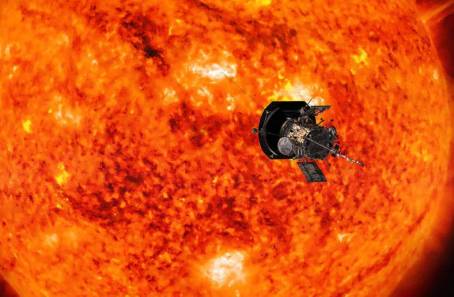NASA’s cutting-edge Parker Solar Probe is about to get 3.8 million miles (6.2 million kilometers) from the Sun, which will be the closest it has ever been. This will happen on Christmas Eve.
The spaceship was launched in August 2018 and will be there for seven years to help scientists learn more about our star and predict space weather events that could affect life on Earth.
The spaceship would be about four yards (meters) from the end zone at that point if the distance between Earth and the Sun is the same as the length of an American football field.
Parker Solar Probe program scientist Arik Posner said in a statement, “This is an example of one of NASA’s brave missions. They are doing something that no one else has ever done before to answer long-standing questions about our universe.”
“We can’t wait to receive that first status update from the spacecraft and start receiving the science data in the coming weeks.”
During this closest approach, called perihelion, mission teams will lose direct touch with Parker. This Friday, a “beacon tone” will let them know what’s going on with the spacecraft.
The heat shield will be exposed to very hot temperatures of about 1,600 to 1,700 degrees Fahrenheit (870 to 930 degrees Celsius), but the sensors inside the probe will stay close to room temperature, at about 85F (29C), as it explores the corona, the Sun’s outer atmosphere.
Not only will it be very hot, but Parker will be going very quickly—about 430,000 mph (690,000 kph), which is fast enough to fly from Washington, DC, to Tokyo in less than a minute.
“No man-made object has ever come this close to a star,” said Nick Pinkine, operations manager for the Parker Solar Probe project at the Johns Hopkins Applied Physics Laboratory (APL) in Laurel, Maryland. “Peter will really be returning data from uncharted territory.”
“We’re excited to hear back from the spacecraft when it swings back around the Sun.”
Parker has been going into these harsh conditions to help scientists figure out some of the Sun’s biggest puzzles, like where the solar wind comes from, why the corona is hotter than the surface, and how coronal mass ejections, which are huge clouds of plasma that shoot through space, are made.
Also Read: Why Nasa Thinks a 36-pixel Camera Will Work
The first of three record-setting close passes will happen on Christmas Eve. The next two, on March 22, 2025, and June 19, 2025, will also bring Parker Solar Probe back to a similar close distance from the Sun.
What do you say about this story? Visit Parhlo World For more.


